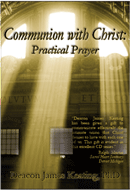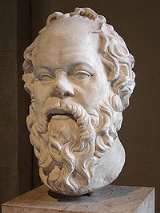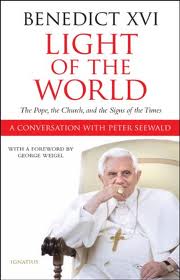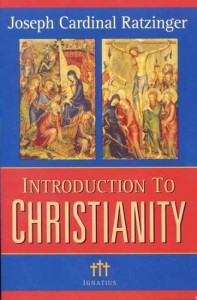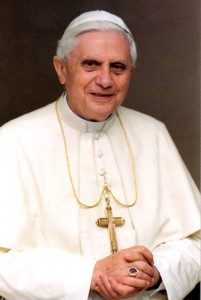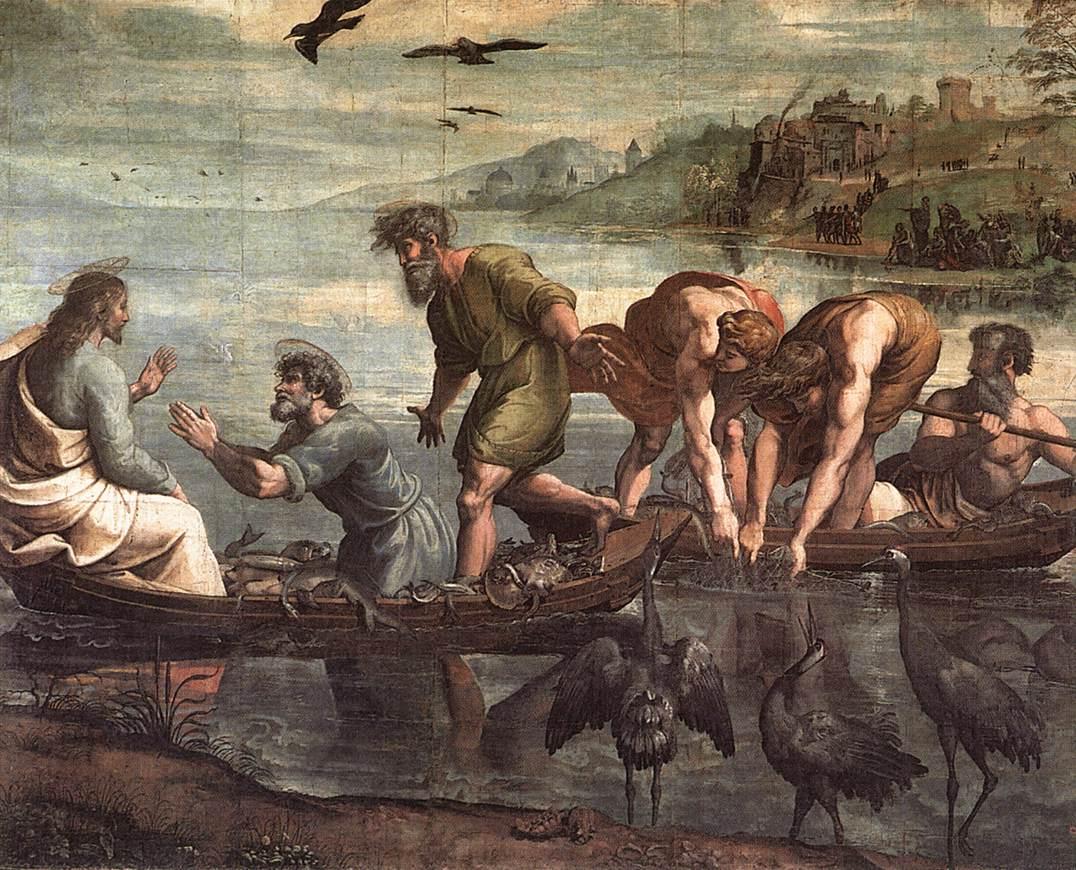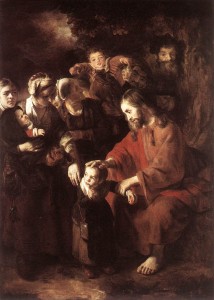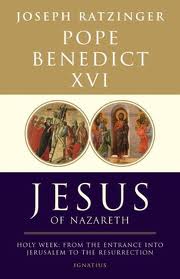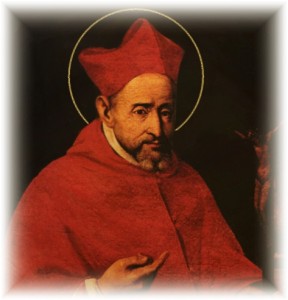Is Jesus Calling? A Spiritual Guide to Discerning Your Vocational Call with Fr. Paul Hoesing – episode 5: 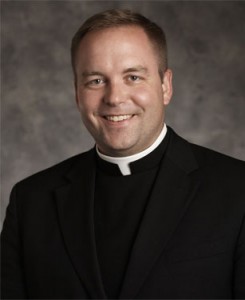 The Sixth Spiritual Lesson: Your fear is from the spirit against Christ. “God does not reveal himself through fear, pressure or confusion. Â This where the spirit against Christ reveals himself.”
The Sixth Spiritual Lesson: Your fear is from the spirit against Christ. “God does not reveal himself through fear, pressure or confusion. Â This where the spirit against Christ reveals himself.”
Questions: What are your ideas and images of god the Father and how do they differ from what Jesus teaches us about the Father?  Do you see the Father as someone who pressures you to do things?  Where does fear drive your relationship with the Father?  Recall your latest experience of peace, stillness, clarity and gratitude in God and believe that that is how the Father draws you?
[powerpress feed]
The Seventh Spiritual Lesson: God’s will is found in your will when you are in Christ. “God’s will, His desire for you, is not out there somwhere! Â It is found in your own desire when you are in Christ! Â That is the will of God for you!”
Questions: Does the thought of the priesthood come into your thoughts, feelings and desires when you are experiencing the peaceful presence of God?
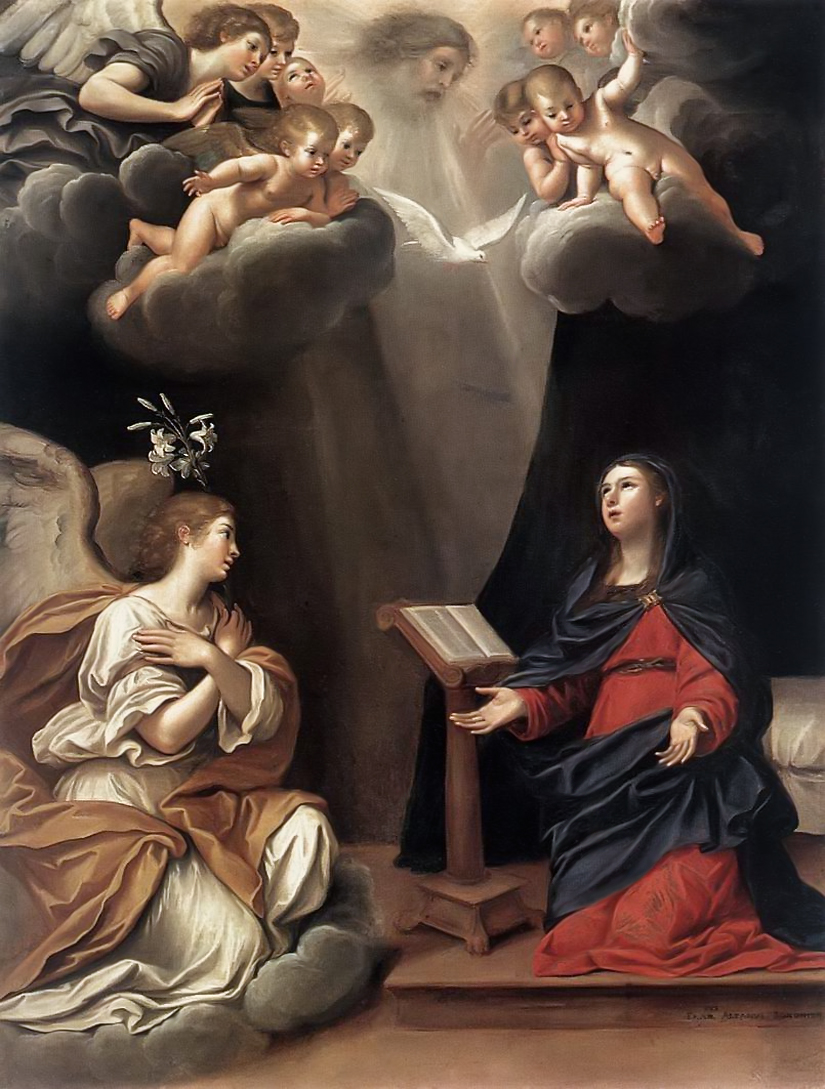 Based on “Is Jesus Calling You To Be A Catholic Priest: A helpful guide”, published by National Conference of Diocesan Vocation Director.
Based on “Is Jesus Calling You To Be A Catholic Priest: A helpful guide”, published by National Conference of Diocesan Vocation Director.
Fr. Paul Hoesing serves as the Vocation Director for the Archdiocese of Omaha, NE.
Check out “For Your Vocation.org“
Tags: archdiocese of omaha, catholic, catholic podcast, catholic prayer, catholic priest, cathollc spirituality, discernment, married life, Paul Hoesing, priesthood, religious life, spiritual guide, Spiritual Lesson, vocation director
This entry was posted on Monday, May 9th, 2011 at 2:49 pm
You can follow any responses to this entry through the RSS 2.0 feed.
Episode 18 -The Way of Mystery: The Eucharist and Moral Living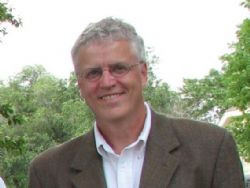 – The Final installment of the series. The challenge of living the moral life and the gift of grace from the sacrament of the Eucharist.
– The Final installment of the series. The challenge of living the moral life and the gift of grace from the sacrament of the Eucharist.
[powerpress]
Deacon James Keating, PhD, the director of Theological Formation for the Institute for Priestly Formation, located at Creighton University, in Omaha, is making available to â€Discerning Hearts†and all who listen, his series of programs entitled “The Way of Mysteryâ€.
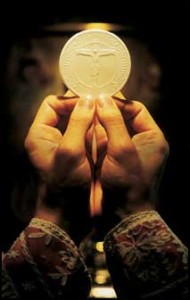 The Vatican II documents remind us that the spiritual journey is not made in a vacuum, that God has chosen to save us, not individually, but as The People of God. The Eucharist must help Christians to make their choices by discerning out of Christ’s paschal mystery. For this process to take place, however, Christians must first understand how the Eucharist puts them in touch with Christ’s passion, death, and resurrection, and what concrete implications being in touch with this mystery has for their daily lives.
The Vatican II documents remind us that the spiritual journey is not made in a vacuum, that God has chosen to save us, not individually, but as The People of God. The Eucharist must help Christians to make their choices by discerning out of Christ’s paschal mystery. For this process to take place, however, Christians must first understand how the Eucharist puts them in touch with Christ’s passion, death, and resurrection, and what concrete implications being in touch with this mystery has for their daily lives.
For more information on the “Institute of Priestly Formation†and for other material available by Deacon Keating, just click here
Don’t forget to pickup a copy of “Communion with Christ†, it is one of the best audio sets on prayer…ever!
Check out Deacon Keating’s “Discerning Heart†page
Tags: catholic, catholic podcast, catholic prayer, cathollc spirituality, creighton university, Deacon James Keating, institute for priestly formation, james keating, paschal mystery, sacrament of the eucharist, the eucharist, theological formation
This entry was posted on Thursday, May 5th, 2011 at 2:26 pm
You can follow any responses to this entry through the RSS 2.0 feed.
Here is the This is the English translation of the extended remarks of the Holy Father, Â found on the Vatican website, from his audience on May 4 on
“The man in prayer”
Dear brothers and sisters,
Today I would like to begin a new series of Catecheses. After the series on the Fathers of the Church, on the great theologians of the Middle Ages and on great women, I would now like to choose a topic that is dear to all our hearts: it is the theme of prayer, and especially Christian prayer, the prayer, that is, which Jesus taught and which the Church continues to teach us. It is in fact in Jesus that man becomes able to approach God in the depth and intimacy of the relationship of fatherhood and sonship. Together with the first disciples, let us now turn with humble trust to the Teacher and ask him: “Lord, teach us to pray†(Lk 11:1).
In the upcoming Catechesis, in comparing Sacred Scripture, the great tradition of the Fathers of the Church, of the Teachers of spirituality and of the Liturgy, let us learn to live our relationship with the Lord, even more intensely as it were at a “school of prayerâ€.
Because we know that prayer can not be taken for granted: we must learn to pray, as if gaining back this art, even those who are very advanced in the spiritual life always feel the need to get to school to learn to Jesus pray with authenticity. We receive the first lesson from the Lord through His example. The Gospels describe Jesus in intimate and ongoing dialogue with the Father is a deep communion of the one who came into the world not to do his will, but the Father who sent him for the salvation of man.
In this first catechesis, as an introduction, I would like to propose some examples of prayer in ancient cultures, as noted, almost always and everywhere have turned to God
I shall start with ancient Egypt, as an example. Here a blind man, asking the divinity to restore his sight, testifies to something universally human. This is a pure and simple prayer of petition by someone who is suffering. This man prays: “My heart longs to see you…. You who made me see the darkness, create light for me, so that I may see you! Bend your beloved face over me†(A. Barucq — F. Daumas, Hymnes et prières de l’Egypte ancienne, Paris 1980). That I may see you; this is the essence of the prayer!
In the religions of Mesopotamia an arcane, paralyzing sense of guilt predominated, but which was not devoid of the hope of redemption and liberation on God’s part. We may thus appreciate this entreaty by a believer of those ancient cultures, formulated in these words: “O God who are indulgent even in the greatest sin, absolve me from my sin…. Look, O Lord at your tired servant and blow your breeze upon him: forgive him without delay. Alleviate your severe punishment. Freed from bonds, grant that I may breathe anew, break my chains, loosen the fetters that bind me†(M.-J. Seux, Hymnes et Prières aux Dieux de Babylone et d’Assyrie, Paris 1976). These are words that demonstrate how the human being, in his search for God, had intuited, if vaguely, on the one hand his own guilt and on the other, aspects of divine mercy and goodness.
In the pagan religion of ancient Greece, a very significant development may be seen: prayers, while still invoking divine help to obtain heavenly favours in every circumstance of daily life and to receive material benefits, gradually became orientated to more disinterested requests, which enabled the believer to deepen his or her relationship with God and to become a better person.
For example, the great philosopher Plato records a prayer of his teacher, Socrates, held to be one of the founders of Western thought. This was Socrates’ prayer: “Grant to me that I be made beautiful in my soul within, and that all external possessions be in harmony with my inner man. May I consider the wise man rich; and may I have such wealth as only the self-restrained man can bear or endure†(Plato, Phaedrus, English trans.: Loeb, Harold North Fowler). Rather than to possess plenty of money, he wanted above all to be beautiful within and wise.
In the Greek tragedies, sublime masterpieces of the literature of all time which still, after 25 centuries, are read, thought about and performed today, there is a content of prayer which expresses the desire to know God and to worship his majesty. One of these tragedies says: “O Earth’s Upbearer, thou whose throne is Earth, Who’er thou be, O past our finding out, Zeus, be thou Nature’s Law, or Mind of man, Thee I invoke; for, treading soundless paths, To Justice’ goal thou bringest all mortal things†(Euripedes, Trojan Women, 884-886, English trans.: Loeb, Arthur S. Way). God remains somewhat nebulous, nevertheless man knows this unknown god and prays to the one who guides the ways of the world.
Also among the Romans who made up that great Empire in which Christianity first came into being and spread, prayer, even if it is associated with a utilitarian conception and fundamentally associated with the request for divine protection of the life of the civil community, sometimes begins with invocations that are wonderful for the fervour of personal devotion that is transformed into praise and thanksgiving. In the second century A.D., Apuleius, an author of Roman Africa, attested to this. In his writings he expresses his contemporaries’ dissatisfaction with the traditional religion and the desire for a more authentic relationship with God. In his masterpiece, entitled Metamorphoses, a believer addresses these words to a goddess: “You are holy, you are in every epoch a saviour of the human species, you, in your generosity, always help mortals, offer to the wretch in travail the tender affection
of a mother. Neither a day nor a night nor even a second pass without you filling it with your benefits†(Apuleius of Madaura, Metamorphoses ix, 25).
In the same period the Emperor Marcus Aurelius — who was also a philosopher who reflected on the human condition — affirmed the need to pray in order to establish a fruitful cooperation between divine action and human action. He wrote in his Meditations: “Who told you that the gods do not help us also in what depends on us? So begin to pray to them and you will see†(Dictionnaire de Spiritualité xii/2, col. 2213).
This advice of the Emperor philosopher was effectively put into practice by innumerable generations prior to Christ, thereby demonstrating that human life without prayer, which opens our existence to the mystery God, lacks sense and direction.
Always expressed in every prayer, in fact, is the truth of the human creature who on the one hand experiences weakness and impoverishment, who therefore addresses his supplication to Heaven, and on the other is endowed with an extraordinary dignity, so that, in preparing to receive the divine Revelation, finds himself able to enter into communion with God.
Dear friends, in these examples of prayer of different epochs and civilizations emerge the human being’s awareness of his creatural condition and of his dependence on Another superior to him and the source of every good. The human being of all times prays because he cannot fail to wonder about the meaning of his life, which remains obscure and discomforting of it is not put in relations to the mystery of God and if his plan for the world.
Human life is a fabric woven of good and of evil, of undeserved suffering and of joy and beauty that spontaneously and irresistibly impel us to ask God for that light and that inner strength which support us on earth and reveal a hope beyond the boundaries of death.
The pagan religions remain an invocation which from the earth awaits a word from Heaven. One of the last great pagan philosophers, who lived fully in the Christian era, Proclus of Constantinople, gives a voice to this expectation, saying: “unknowable, no one contains you. All that we think belongs to you. Our evils and our good come from you, on you our every yearning depends, O Ineffable One, whom our souls feel present, raising to you a hymn of silence†(Hymni, ed. Vogt, Wiesbaden 1957, in Preghiere dell’umanità , op. cit., p. 61).
In the examples of prayer of the various cultures which we have considered, we can see a testimony of the religious dimension and of the desire for God engraved on the heart of every human being, which receives fulfilment and full expression in the Old and in the New Testament. The Revelation, is in fact purifying and brings to its fullness man’s original yearning for God, offering to him, in prayer, the possibility of a deeper relationship with the heavenly Father.
At the beginning of our journey in the “school of prayer†let us now ask the Lord to illumine our minds and hearts so that the relationship with him in prayer may be ever more intense, affectionate and constant. Once again, let us say to him: “Lord, teach us to pray†(Lk 11:1).
Tags: catholic, catholic podcast, catholic prayer, cathollc spirituality, christian prayer
This entry was posted on Wednesday, May 4th, 2011 at 2:33 pm
You can follow any responses to this entry through the RSS 2.0 feed.
Here is Pope Benedict XVI’s homily for the Mass of beatification:
Dear Brothers and Sisters,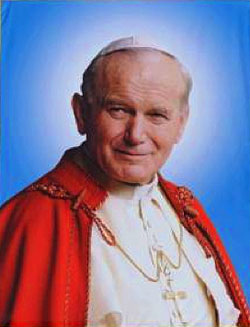
Six years ago we gathered in this Square to celebrate the funeral of Pope John Paul II. Our grief at his loss was deep, but even greater was our sense of an immense grace which embraced Rome and the whole world: a grace which was in some way the fruit of my beloved predecessor’s entire life, and especially of his witness in suffering. Even then we perceived the fragrance of his sanctity, and in any number of ways God’s People showed their veneration for him. For this reason, with all due respect for the Church’s canonical norms, I wanted his cause of beatification to move forward with reasonable haste. And now the longed-for day has come; it came quickly because this is what was pleasing to the Lord: John Paul II is blessed!
I would like to offer a cordial greeting to all of you who on this happy occasion have come in such great numbers to Rome from all over the world – cardinals, patriarchs of the Eastern Catholic Churches, brother bishops and priests, official delegations, ambassadors and civil authorities, consecrated men and women and lay faithful, and I extend that greeting to all those who join us by radio and television.
Today is the Second Sunday of Easter, which Blessed John Paul II entitled Divine Mercy Sunday. The date was chosen for today’s celebration because, in God’s providence, my predecessor died on the vigil of this feast. Today is also the first day of May, Mary’s month, and the liturgical memorial of Saint Joseph the Worker. All these elements serve to enrich our prayer, they help us in our pilgrimage through time and space; but in heaven a very different celebration is taking place among the angels and saints! Even so, God is but one, and one too is Christ the Lord, who like a bridge joins earth to heaven. At this moment we feel closer than ever, sharing as it were in the liturgy of heaven.
“Blessed are those who have not seen and yet have come to believe” (Jn 20:29). In today’s Gospel Jesus proclaims this beatitude: the beatitude of faith. For us, it is particularly striking because we are gathered to celebrate a beatification, but even more so because today the one proclaimed blessed is a Pope, a Successor of Peter, one who was called to confirm his brethren in the faith. John Paul II is blessed because of his faith, a strong, generous and apostolic faith. We think at once of another beatitude: “Blessed are you, Simon, son of Jonah! For flesh and blood has not revealed this to you, but my Father in heaven” (Mt 16:17). What did our heavenly Father reveal to Simon? That Jesus is the Christ, the Son of the living God. Because of this faith, Simon becomes Peter, the rock on which Jesus can build his Church. The eternal beatitude of John Paul II, which today the Church rejoices to proclaim, is wholly contained in these sayings of Jesus: “Blessed are you, Simon” and “Blessed are those who have not seen and yet have come to believe!” It is the beatitude of faith, which John Paul II also received as a gift from God the Father for the building up of Christ’s Church.
Our thoughts turn to yet another beatitude, one which appears in the Gospel before all others. It is the beatitude of the Virgin Mary, the Mother of the Redeemer. Mary, who had just conceived Jesus, was told by Saint Elizabeth: “Blessed is she who believed that there would be a fulfilment of what was spoken to her by the Lord” (Lk 1:45). The beatitude of faith has its model in Mary, and all of us rejoice that the beatification of John Paul II takes place on this first day of the month of Mary, beneath the maternal gaze of the one who by her faith sustained the faith of the Apostles and constantly sustains the faith of their successors, especially those called to occupy the Chair of Peter. Mary does not appear in the accounts of Christ’s resurrection, yet hers is, as it were, a continual, hidden presence: she is the Mother to whom Jesus entrusted each of his disciples and the entire community. In particular we can see how Saint John and Saint Luke record the powerful, maternal presence of Mary in the passages preceding those read in today’s Gospel and first reading. In the account of Jesus’ death, Mary appears at the foot of the cross (Jn 19:25), and at the beginning of the Acts of the Apostles she is seen in the midst of the disciples gathered in prayer in the Upper Room (Acts 1:14).
Today’s second reading also speaks to us of faith. Saint Peter himself, filled with spiritual enthusiasm, points out to the newly-baptized the reason for their hope and their joy. I like to think how in this passage, at the beginning of his First Letter, Peter does not use language of exhortation; instead, he states a fact. He writes: “you rejoice”, and he adds: “you love him; and even though you do not see him now, you believe in him and rejoice with an indescribable and glorious joy, for you are receiving the outcome of your faith, the salvation of your souls” (1 Pet 1:6, 8-9). All these verbs are in the indicative, because a new reality has come about in Christ’s resurrection, a reality to which faith opens the door. “This is the Lord’s doing”, says the Psalm (118:23), and “it is marvelous in our eyes”, the eyes of faith.
Dear brothers and sisters, today our eyes behold, in the full spiritual light of the Risen Christ, the beloved and revered figure of John Paul II. Today his name is added to the host of those whom he proclaimed saints and blesseds during the almost twenty-seven years of his pontificate, thereby forcefully emphasizing the universal vocation to the heights of the Christian life, to holiness, taught by the conciliar Constitution on the Church Lumen Gentium. All of us, as members of the people of God – bishops, priests, deacons, laity, men and women religious – are making our pilgrim way to the heavenly homeland where the Virgin Mary has preceded us, associated as she was in a unique and perfect way to the mystery of Christ and the Church. Karol WojtyÅ‚a took part in the Second Vatican Council, first as an auxiliary Bishop and then as Archbishop of Kraków. He was fully aware that the Council’s decision to devote the last chapter of its Constitution on the Church to Mary meant that the Mother of the Redeemer is held up as an image and model of holiness for every Christian and for the entire Church. This was the theological vision which Blessed John Paul II discovered as a young man and subsequently maintained and deepened throughout his life. A vision which is expressed in the scriptural image of the crucified Christ with Mary, his Mother, at his side. This icon from the Gospel of John (19:25-27) was taken up in the episcopal and later the papal coat-of-arms of Karol WojtyÅ‚a: a golden cross with the letter “M” on the lower right and the motto “Totus tuus”, drawn from the well-known words of Saint Louis Marie Grignion de Montfort in which Karol WojtyÅ‚a found a guiding light for his life: “Totus tuus ego sum et omnia mea tua sunt. Accipio te in mea omnia. Praebe mihi cor tuum, Maria – I belong entirely to you, and all that I have is yours. I take you for my all. O Mary, give me your heart” (Treatise on True Devotion to the Blessed Virgin, 266).
In his Testament, the new Blessed wrote: “When, on 16 October 1978, the Conclave of Cardinals chose John Paul II, the Primate of Poland, Cardinal Stefan WyszyÅ„ski, said to me: ‘The task of the new Pope will be to lead the Church into the Third Millennium'”. And the Pope added: “I would like once again to express my gratitude to the Holy Spirit for the great gift of the Second Vatican Council, to which, together with the whole Church – and especially with the whole episcopate – I feel indebted. I am convinced that it will long be granted to the new generations to draw from the treasures that this Council of the twentieth century has lavished upon us. As a Bishop who took part in the Council from the first to the last day, I desire to entrust this great patrimony to all who are and will be called in the future to put it into practice. For my part, I thank the Eternal Shepherd, who has enabled me to serve this very great cause in the course of all the years of my Pontificate”. And what is this “cause”? It is the same one that John Paul II presented during his first solemn Mass in Saint Peter’s Square in the unforgettable words: “Do not be afraid! Open, open wide the doors to Christ!” What the newly-elected Pope asked of everyone, he was himself the first to do: society, culture, political and economic systems he opened up to Christ, turning back with the strength of a titan – a strength which came to him from God – a tide which appeared irreversible. By his witness of faith, love and apostolic courage, accompanied by great human charisma, this exemplary son of Poland helped believers throughout the world not to be afraid to be called Christian, to belong to the Church, to speak of the Gospel. In a word: he helped us not to fear the truth, because truth is the guarantee of liberty. To put it even more succinctly: he gave us the strength to believe in Christ, because Christ is Redemptor hominis, the Redeemer of man. This was the theme of his first encyclical, and the thread which runs though all the others.
When Karol WojtyÅ‚a ascended to the throne of Peter, he brought with him a deep understanding of the difference between Marxism and Christianity, based on their respective visions of man. This was his message: man is the way of the Church, and Christ is the way of man. With this message, which is the great legacy of the Second Vatican Council and of its “helmsman”, the Servant of God Pope Paul VI, John Paul II led the People of God across the threshold of the Third Millennium, which thanks to Christ he was able to call “the threshold of hope”. Throughout the long journey of preparation for the great Jubilee he directed Christianity once again to the future, the future of God, which transcends history while nonetheless directly affecting it. He rightly reclaimed for Christianity that impulse of hope which had in some sense faltered before Marxism and the ideology of progress. He restored to Christianity its true face as a religion of hope, to be lived in history in an “Advent” spirit, in a personal and communitarian existence directed to Christ, the fullness of humanity and the fulfillment of all our longings for justice and peace.
Finally, on a more personal note, I would like to thank God for the gift of having worked for many years with Blessed Pope John Paul II. I had known him earlier and had esteemed him, but for twenty-three years, beginning in 1982 after he called me to Rome to be Prefect of the Congregation for the Doctrine of the Faith, I was at his side and came to revere him all the more. My own service was sustained by his spiritual depth and by the richness of his insights. His example of prayer continually impressed and edified me: he remained deeply united to God even amid the many demands of his ministry. Then too, there was his witness in suffering: the Lord gradually stripped him of everything, yet he remained ever a “rock”, as Christ desired. His profound humility, grounded in close union with Christ, enabled him to continue to lead the Church and to give to the world a message which became all the more eloquent as his physical strength declined. In this way he lived out in an extraordinary way the vocation of every priest and bishop to become completely one with Jesus, whom he daily receives and offers in the Church.
Blessed are you, beloved Pope John Paul II, because you believed! Continue, we implore you, to sustain from heaven the faith of God’s people. You often blessed us in this Square from the Apostolic Palace: Bless us, Holy Father! Amen.
Tags: blessed john paul, catholic, catholic podcast, catholic prayer, cathollc spirituality, homily for blessed john paul
This entry was posted on Sunday, May 1st, 2011 at 1:12 pm
You can follow any responses to this entry through the RSS 2.0 feed.
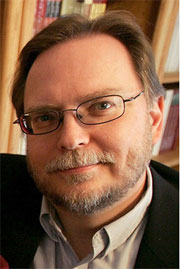 I can’t get enough from Pope Benedict XVI, especially when he shares with all of us his innermost thoughts and insights! “Light of the World: The Pope, The Church and the Signs of the Times” by Peter Seewald had such a fascinating conversation with our Holy Father that it seems to be the gift that just keeps giving. Mark Brumley took time out of his busy day as president of Ignatius Press to shed more “light” on this incredible book and the pontificate of Pope Benedict XVI.
I can’t get enough from Pope Benedict XVI, especially when he shares with all of us his innermost thoughts and insights! “Light of the World: The Pope, The Church and the Signs of the Times” by Peter Seewald had such a fascinating conversation with our Holy Father that it seems to be the gift that just keeps giving. Mark Brumley took time out of his busy day as president of Ignatius Press to shed more “light” on this incredible book and the pontificate of Pope Benedict XVI.
[powerpress]
Check out more on the book here
Tags: catholic, catholic podcast, catholic prayer, cathollc spirituality, holy father, ignatius press, mark brumley, peter seewald, pope benedict xvi
This entry was posted on Monday, April 11th, 2011 at 5:17 pm
You can follow any responses to this entry through the RSS 2.0 feed.
“Introduction to Christianity” by Cardinal Joseph Ratizinger (Pope Benedict XVI) is a modern day classic! Fr. Joseph Fessio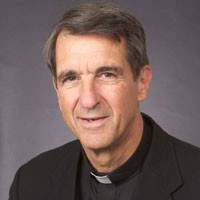 S.J., founder of Ignatius Press and student of Pope Benedict, joins us to break open the gift of insight and wisdom contained in this inspirational work of our Holy Father. As the Pope Benedict states in the preface in the 2nd edition of the book, that approach, taken in the book, puts the question of God and the question about Christ in the very center, which leads to a “narrative Christology” and demonstrates that the place for faith is in the Church. It is an excellent edition to all Christian libraries and a must for anyone seeking a richer appreciation of the teachings of faith. Pope Benedict uses the Old and New Testament, the teachings of the Fathers of the Church and generations of Saints, as well as the beauty of the Church’s Tradition to ponder the reality of Christ. It’s beautiful!
S.J., founder of Ignatius Press and student of Pope Benedict, joins us to break open the gift of insight and wisdom contained in this inspirational work of our Holy Father. As the Pope Benedict states in the preface in the 2nd edition of the book, that approach, taken in the book, puts the question of God and the question about Christ in the very center, which leads to a “narrative Christology” and demonstrates that the place for faith is in the Church. It is an excellent edition to all Christian libraries and a must for anyone seeking a richer appreciation of the teachings of faith. Pope Benedict uses the Old and New Testament, the teachings of the Fathers of the Church and generations of Saints, as well as the beauty of the Church’s Tradition to ponder the reality of Christ. It’s beautiful!
[powerpress]
For more information on this work as well as all the books by Joseph Cardinal Ratzinger (Pope Benedict XVI), go to www.ignatius.com
Tags: cardinal joseph ratizinger, catholic, catholic podcast, catholic prayer, cathollc spirituality, christian classic, Church, faith, ignatius press, introduction to christianity, joseph cardinal ratzinger, joseph fessio, pope benedict, pope benedict xvi, work
This entry was posted on Monday, April 4th, 2011 at 10:24 am
You can follow any responses to this entry through the RSS 2.0 feed.
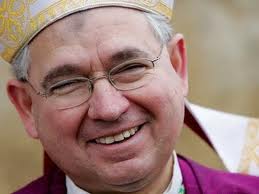 Archbishop Jose Gomez, now the Archbishop of Los Angeles, in 2007 took some time out of his busy day to talk with Bruce and I about his pastoral letter “The Tender Mercy of God” which at the time he addressed to his people of San Antonio.
Archbishop Jose Gomez, now the Archbishop of Los Angeles, in 2007 took some time out of his busy day to talk with Bruce and I about his pastoral letter “The Tender Mercy of God” which at the time he addressed to his people of San Antonio.
[powerpress]
Our friend, David Scott, brought the letter to our attention and encouraged us to speak with his Excellency about it. To our wonderful surprise, Archbishop Gomez agreed and was more than generous with his time and insights. Don’t miss out on this wonderful teaching from one of our most gifted shepherds. It really kicks in by page 3.
[gview file=”http://abpgomez.la-archdiocese.org/docs/PASTORAL_LTR/2007-0221_Pastoral_Letter_SA.pdf”]
Tags: archbishop gomez, catholic, catholic podcast, catholic prayer, cathollc spirituality, jose gomez, mercy of god, pastoral letter
This entry was posted on Sunday, March 27th, 2011 at 11:56 am
You can follow any responses to this entry through the RSS 2.0 feed.
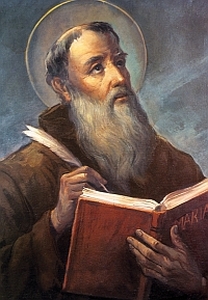 VATICAN CITY, 23 MAR 2011 (VIS) – In his general audience this morning, Benedict XVI dedicated his catechesis to St. Lawrence of Brindisi (born Giulio Cesare Rossi, 1559-1619), a Doctor of the Church.
VATICAN CITY, 23 MAR 2011 (VIS) – In his general audience this morning, Benedict XVI dedicated his catechesis to St. Lawrence of Brindisi (born Giulio Cesare Rossi, 1559-1619), a Doctor of the Church.
The saint, who lost his father at the age of seven, was entrusted by his mother to the care of the Friars Minor Conventuals. He subsequently entered the Order of Capuchins and was ordained a priest in 1582. He acquired a profound knowledge of ancient and modern languages, thanks to which “he was able to undertake an intense apostolate among various categories of people“, the Pope explained. He was also an effective preacher well versed not only in the Bible but also in rabbinic literature, which he knew so well “that rabbis themselves were amazed and showed him esteem and respect”.
As a theologian and expert in Sacred Scripture and the Church Fathers, Lawrence of Brindisi was an exemplary teacher of Catholic doctrine among those Christians who, especially in Germany, had adhered to the Reformation. “With his clear and tranquil explanations he demonstrated the biblical and patristic foundation of all the articles of faith called into question by Martin Luther, among them the primacy of St. Peter and his Successors, the divine origin of the episcopate, justification as interior transformation of man, and the necessity of good works for salvation. The success enjoyed by St. Lawrence helps us to understand that even today, as the hope-filled journey of ecumenical dialogue continues, the reference to Sacred Scripture, read in the Tradition of the Church, is an indispensable element of fundamental importance”.
“Even the lowliest members of the faithful who did not possess vast culture drew advantage from the convincing words of St. Lawrence, who addressed the humble in order to call everyone to live a life coherent with the faith they professed”, said the Holy Father. “This was a great merit of the Capuchins and of the other religious orders which, in the sixteenth and seventeenth centuries, contributed to the renewal of Christian life. … Even today, the new evangelisation needs well-trained, zealous and courageous apostles, so that the light and beauty of the Gospel may prevail over the cultural trends of ethical relativism and religious indifference, transforming the various ways people think and act in an authentic Christian humanism”.
Lawrence was a professor of theology, master of novices, minister provincial and minister general of the Capuchin Order, but amidst all these tasks “he also cultivated an exceptionally active spiritual life”, the Pope said. In this context he noted how all priests “can avoid the danger of activism – that is, of acting while forgetting the profound motivations of their ministry – only if they pay heed to their own inner lives”.
The Holy Father then turned his attention to another aspect of the saint’s activities: his work in favour of peace. 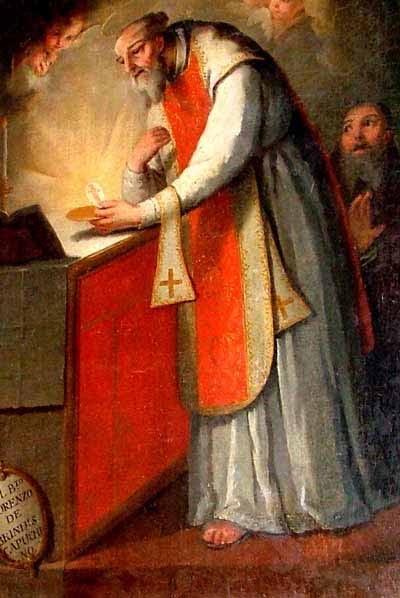 “Supreme Pontiffs and Catholic princes repeatedly entrusted him with important diplomatic missions to placate controversies and favour harmony between European States, which at the time were threatened by the Ottoman Empire. Today, as in St. Lawrence’s time, the world has great need of peace, it needs peace-loving and peace-building men and women. Everyone who believes in God must always be a source of peace and work for peace”, he said.
“Supreme Pontiffs and Catholic princes repeatedly entrusted him with important diplomatic missions to placate controversies and favour harmony between European States, which at the time were threatened by the Ottoman Empire. Today, as in St. Lawrence’s time, the world has great need of peace, it needs peace-loving and peace-building men and women. Everyone who believes in God must always be a source of peace and work for peace”, he said.
Lawrence of Brindisi was canonised in 1881 and declared a Doctor of the Church by Blessed John XXIII in 1959 in recognition of his many works of biblical exegesis and Mariology. In his writings, Lawrence “also highlighted the action of the Holy Spirit in the lives of believers”, the Pope said.
“St. Lawrence of Brindisi”, he concluded, “teaches us to love Sacred Scripture, to become increasingly familiar with it, daily to cultivate our relationship with the Lord in prayer, so that our every action, our every activity, finds its beginning and its fulfilment in Him”.
AG/ VIS 20110323 (650)
Published by VIS – Holy See Press Office – Wednesday, March 23, 2011
Tags: capuchins, catholic, catholic podcast, catholic prayer, cathollc spirituality, doctor of the church, sacred scripture, st lawrence of brindisi
This entry was posted on Wednesday, March 23rd, 2011 at 7:31 pm
You can follow any responses to this entry through the RSS 2.0 feed.
Is Jesus Calling? A Spiritual Guide to Discerning Your Vocational Call with Fr. Paul Hoesing – episode 2:  The First Spiritual Lesson: You Must Follow Christ. “Discovering one’s vocation is not a navel-gazing, self-focused, psychological exercise.  It’s not about a man figuring something out. It is not about solving a confusing puzzle.”
The First Spiritual Lesson: You Must Follow Christ. “Discovering one’s vocation is not a navel-gazing, self-focused, psychological exercise.  It’s not about a man figuring something out. It is not about solving a confusing puzzle.”
Questions: Where have you encountered Christ? Where do you experience his loving presence now for you?  Where do you feel consciously blessed and grateful for what God has done for you?
[powerpress feed]
The Second Spiritual Lesson: Learn to desire what God desires for you. “All you need is to desire whatever God may desire for you. Remaining true to this desire opens your heart to receive what God wants for you. Then, God Himself will take care of you.â€
Questions: Do you trust that God always wants what is best for you? Where do you begin to become afraid of giving God permission to lead you? When do you begin to try to manipulate God to want what you think will make you happy? When that happens, simply say over and over again inside of yourself to the Father, ‘Father, I give you permission to lead me!’ Or ‘Father, I desire your goodness to me.’ Or, ‘Father, I trust you’â€
Based on “Is Jesus Calling You To Be A Catholic Priest: A helpful guide”, published by Nati onal Conference of Diocesan Vocation Director.
Fr. Paul Hoesing serves as the Vocation Director for the Archdiocese of Omaha, NE.
Check out “For Your Vocation.org”
Tags: archdiocese of omaha, catholic, catholic podcast, catholic prayer, catholic priest, cathollc spirituality, discernment, heart, married life, NE, Paul Hoesing, religious life, spiritual guide, vocation director
This entry was posted on Monday, March 21st, 2011 at 12:57 am
You can follow any responses to this entry through the RSS 2.0 feed.
Episode 2 Jesus of Nazareth part 2: Holy Week From the Entrance into Jerusalem to the  Resurrction by Pope Benedict XVI is INCREDIBLE…absolutely worth the wait! It would be like making a “sophie’s choice” to pick between the two, but if I had to, this work by our Holy Father would be it. A meditation which brings us to contemplate the person of Jesus…especially meaningful in the context of Holy Week and Easter! Pope Benedict XVI shows us once again the importance of making the journey from the “head to the heart”. Mark Brumley is a master in breaking open the riches found in this treasure box of a book.
Resurrction by Pope Benedict XVI is INCREDIBLE…absolutely worth the wait! It would be like making a “sophie’s choice” to pick between the two, but if I had to, this work by our Holy Father would be it. A meditation which brings us to contemplate the person of Jesus…especially meaningful in the context of Holy Week and Easter! Pope Benedict XVI shows us once again the importance of making the journey from the “head to the heart”. Mark Brumley is a master in breaking open the riches found in this treasure box of a book.
Visit the Jesus of Nazareth II site
[powerpress]
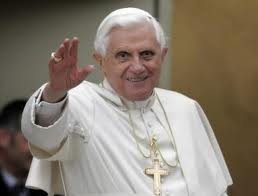
For part 1 of our discussion with Mark visit: IP#85 Mark Brumley – Pope Benedict’s XVI’s Jesus of Nazareth part 2 on Inside the Pages ep 1
Tags: catholic, catholic podcast, catholic prayer, cathollc spirituality, holy week, jesus of nazareth, mark brumley, pope benedict, pope benedict xvi
This entry was posted on Monday, March 14th, 2011 at 7:18 pm
You can follow any responses to this entry through the RSS 2.0 feed.
And I love our Holy Father too!
Tags: catholic, catholic podcast, catholic prayer, cathollc spirituality, jesus of nazareth, pope benedict xvi
This entry was posted on Thursday, March 10th, 2011 at 4:40 pm
You can follow any responses to this entry through the RSS 2.0 feed.
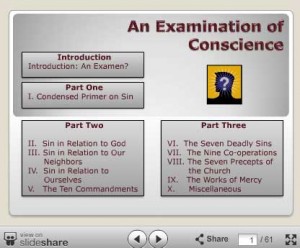 Baltimore Catechism to the Catholic Catechism, from the Ten Commandments to the 7 Deadly Sins, through in Archbishop Fulton Sheen and you have the help that can get through Lent and beyond…but first and foremost, start with PRAYER…come back now and then to check out different sections . Now let’s dive into the great well of grace and mercy found in the Sacrament of Reconciliation!
Baltimore Catechism to the Catholic Catechism, from the Ten Commandments to the 7 Deadly Sins, through in Archbishop Fulton Sheen and you have the help that can get through Lent and beyond…but first and foremost, start with PRAYER…come back now and then to check out different sections . Now let’s dive into the great well of grace and mercy found in the Sacrament of Reconciliation!Tags: 7 deadly sins, archbishop fulton sheen, baltimore catechism, catholic, Catholic Catechism, catholic podcast, catholic prayer, cathollc spirituality, examination of conscience, grace and mercy, OK, prayer, sacrament of reconciliation, ten commandments
This entry was posted on Wednesday, March 9th, 2011 at 12:55 am
You can follow any responses to this entry through the RSS 2.0 feed.
Dr. Scott Hahn has led so many into the heart of the Church through his great sharing of Holy Scripture. With “Signs of 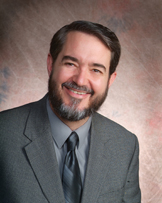 Life: 40 Catholic Customs and Their Biblical Roots” he takes us into the various “chambers of our home”, the Roman Catholic Church. He helps to understand the devotions, prayers, customs and many other spiritual practices which enrich our faith life. The book includes chapters including: the Sign of the Cross, the Mass, the Sacraments, praying with the saints, guardian angels, sacred images and relics, the celebration of Easter, Christmas, and other holidays, daily prayers, and much more. This work has helped me so much, and it’s the gift I give to anyone I know coming into full communion with Church. It’s fantastic!!!!
Life: 40 Catholic Customs and Their Biblical Roots” he takes us into the various “chambers of our home”, the Roman Catholic Church. He helps to understand the devotions, prayers, customs and many other spiritual practices which enrich our faith life. The book includes chapters including: the Sign of the Cross, the Mass, the Sacraments, praying with the saints, guardian angels, sacred images and relics, the celebration of Easter, Christmas, and other holidays, daily prayers, and much more. This work has helped me so much, and it’s the gift I give to anyone I know coming into full communion with Church. It’s fantastic!!!!
[powerpress]
Be sure to visit Dr. Hahn’s website for the St. Paul Center of Biblical Theology at 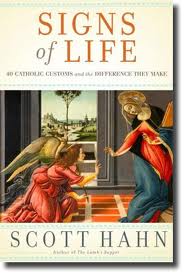 www.salvationhistory.com
www.salvationhistory.com
 Check out the book here
“Professor Hahn’s purpose is both devotional and apologetic. In showing how Catholic popular piety is scripturally grounded, he explains practices that shape Catholic life and help us grow in grace. This is a book that will be helpful to individuals and to the Church as a whole.” — Francis Cardinal George, OMI, Archbishop of Chicago
“Lifelong Catholics realize that it usually takes a convert to help us appreciate and better understand the customs and practices we too often take for granted. Scott Hahn does just that in this immensely reable yet substantive loving look at Catholic prayer, devotions, and beliefs.” — Most Reverend Timothy M. Dolan, Archbishop of New York
Tags: catholic, catholic podcast, catholic prayer, cathollc spirituality
This entry was posted on Thursday, March 3rd, 2011 at 10:22 am
You can follow any responses to this entry through the RSS 2.0 feed.
Episode 15 -The Way of Mystery: The Eucharist and Moral Living– The journey begins into the unitive way…the beginning of falling in love with God. Combined with the entry into the sacramental life, the living out the moral life becomes more than meeting a “goal”, but becomes a “way” of life.
falling in love with God. Combined with the entry into the sacramental life, the living out the moral life becomes more than meeting a “goal”, but becomes a “way” of life.
[powerpress]
Deacon James Keating, PhD, the director of Theological Formation for the Institute for Priestly Formation, located at Creighton University, in Omaha, is making available to â€Discerning Hearts†and all who listen, his series of programs entitled “The Way of Mysteryâ€.
 The Vatican II documents remind us that the spiritual journey is not made in a vacuum, that God has chosen to save us, not individually, but as The People of God. The Eucharist must help Christians to make their choices by discerning out of Christ’s paschal mystery. For this process to take place, however, Christians must first understand how the Eucharist puts them in touch with Christ’s passion, death, and resurrection, and what concrete implications being in touch with this mystery has for their daily lives.
The Vatican II documents remind us that the spiritual journey is not made in a vacuum, that God has chosen to save us, not individually, but as The People of God. The Eucharist must help Christians to make their choices by discerning out of Christ’s paschal mystery. For this process to take place, however, Christians must first understand how the Eucharist puts them in touch with Christ’s passion, death, and resurrection, and what concrete implications being in touch with this mystery has for their daily lives.
For more information on the “Institute of Priestly Formation†and for other material available by Deacon Keating, just click here
Don’t forget to pickup a copy of “Communion with Christ†, it is one of the best audio sets on prayer…ever!
Check out Deacon Keating’s “Discerning Heart†page
Tags: catholic, catholic podcast, catholic prayer, cathollc spirituality, creighton university, Deacon James Keating, institute for priestly formation, moral life, paschal mystery, sacramental life, spiritual journey, the eucharist, the unitive way, theological formation, way of mystery
This entry was posted on Saturday, February 26th, 2011 at 8:08 am
You can follow any responses to this entry through the RSS 2.0 feed.
“His ‘Controversial Works’ or ‘Disputationes’ are still a valid point of reference for Catholic ecclesiology”, said the Holy Father. “They emphasise the institutional aspect of the Church, in response to the errors then circulating on that topic. Yet Bellarmine also threw light on invisible aspects of the Church as Mystical Body, which he explained using the analogy of the body and soul, in order to describe the relationship between the interior richness of the Church and her visible exterior features.
“In this monumental work, which seeks to categorise the various theological controversies of the age, he avoids polemical and aggressive tones towards the ideas of the Reformation but, using the arguments of reason and of Church Tradition, clearly and effectively illustrates Catholic doctrine.
“Nonetheless”, the Pope added, “his true heritage lies in the way in which he conceived his work. His burden of office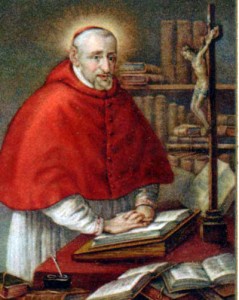 did not, in fact, prevent him from striving daily after sanctity through faithfulness to the requirements of his condition as religious, priest and bishop. … His preaching and catechesis reveal that same stamp of essentiality which he learned from his Jesuit education, being entirely focused on concentrating the power of the soul on the Lord Jesus, intensely known, loved and imitated”.
did not, in fact, prevent him from striving daily after sanctity through faithfulness to the requirements of his condition as religious, priest and bishop. … His preaching and catechesis reveal that same stamp of essentiality which he learned from his Jesuit education, being entirely focused on concentrating the power of the soul on the Lord Jesus, intensely known, loved and imitated”.
In another of his books, “De gemitu columbae” in which the Church is represented as a dove, Robert Bellarmine “forcefully calls clergy and faithful to a personal and concrete reform of their lives, in accordance with the teachings of Scripture and the saints. … With great clarity and the example of his own life, he clearly teaches that there can be no true reform of the Church unless this is first preceded by personal reform and conversion of heart on our part”.
“If you are wise, then understand that you were created for the glory of God and for your eternal salvation”, said the Pope quoting from one of the saint’s works. “Favourable or adverse circumstances, wealth and poverty, health and sickness, honour and offence, life and death, the wise must neither seek these things, nor seek to avoid them per se. They are good and desirable only if they contribute to the glory of God and to your eternal happiness, they are bad and to be avoided if they hinder this”.
The Pope concluded: “These words have not gone out of fashion, but should be meditated upon at length in order to guide our journey on this earth. They remind us that the goal of our life is the Lord. … They remind us of the importance of trusting in God, of living a life faithful to the Gospel, and of accepting all the circumstances and all actions of our lives, illuminating them with faith and prayer”.
Published by VIS – Holy See Press Office
Tags: catholic, catholic podcast, catholic prayer, cathollc spirituality, doctor of the church, spiritual exercises, st robert bellarmine
This entry was posted on Wednesday, February 23rd, 2011 at 8:54 am
You can follow any responses to this entry through the RSS 2.0 feed.


